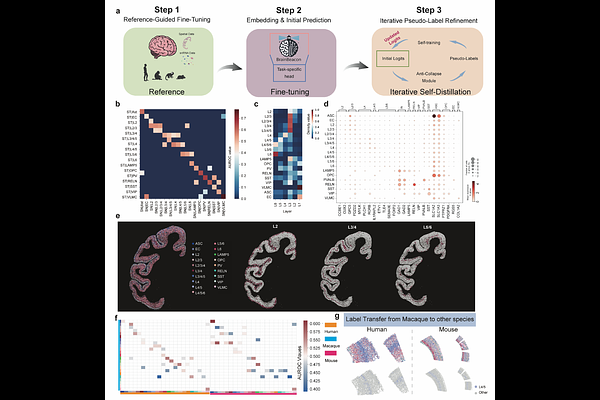BrainBeacon: A Cross-Species Foundation Model for Single-cell Resolved Brain Spatial Transcriptomics

BrainBeacon: A Cross-Species Foundation Model for Single-cell Resolved Brain Spatial Transcriptomics
Zhang, C.; Yang, Y.; Jiao, Y.; Yang, Q.; Guo, X.; Xu, J.; Li, J.; Zhou, Y.; Liu, Z.; Wu, Y.; Zhang, Y.; Jiang, C.; Ma, J.; Liu, Y.; Zhang, Y.; Xiao, K.; Sun, Y.; Liu, C.; Han, L.; Qi, Y.; Aihara, K.; Li, C.; Cheng, Y.; Chen, L.; Wei, W.
AbstractThe brain\'s functional complexity emerges from spatiotemporal heterogeneity in molecular, cellular, and circuit organization, shaped by evolution, aging, and disease. Single-cell spatial transcriptomics provides a transformative framework to decode this complexity, resolving cell-type-specific expression patterns, region-specific regulation, evolutionary divergence, and disease-associated disruptions. Despite recent advances in spatial transcriptomics, a unified foundation model capturing cross-species, whole-brain cellular architecture remains lacking. Here, we introduce BrainBeacon, the first cross-species foundation model for whole-brain spatial transcriptomics. Trained on 133 million spatially resolved cells covering a total area of 210194 mm2 from human, macaque, marmoset and mouse brains profiled across five major platforms, BrainBeacon integrates gene expression rankings, spatial cellular organization, and evolutionarily conserved genetic relationships into a unified transformer-based architecture. A two-stage training strategy captures both intra-cellular transcriptional dependencies and inter-cellular spatial interactions, yielding biologically grounded and interpretable representations of brain structure. Subsequently, BrainBeacon enables cross-species alignment of brain cell types and anatomical regions, facilitating integrative analyses of conserved and divergent cellular architectures. Moreover, it uncovers spatial regulatory mechanisms of aging by predicting bidirectional perturbation responses between cells and their local niche. Together, BrainBeacon serves as a foundational cross-species model for whole-brain spatial transcriptomics, enabling virtual brain atlas construction, systematic in silico perturbation studies, and mechanistic insights into brain disease pathogenesis.